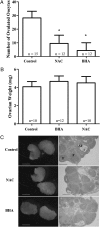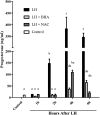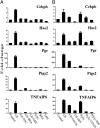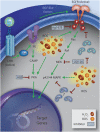Reactive oxygen species are indispensable in ovulation
- PMID: 21220312
- PMCID: PMC3029775
- DOI: 10.1073/pnas.1017213108
Reactive oxygen species are indispensable in ovulation
Abstract
Ovulation is stimulated by the preovulatory surge of the pituitary luteinizing hormone (LH). Because the ovulatory response is commonly identified with inflammation, we explored the involvement of reactive oxygen species (ROS) in this process. Our experiments show that administration of broad-range scavengers of oxidative species into the ovarian bursa of mice, hormonally induced to ovulate, significantly reduced the rate of ovulation. LH-induced cumulus mucification/expansion, a necessary requirement for ovulation, was prevented by antioxidants both in vivo and in an ex vivo system of isolated intact ovarian follicles. Along this line, H(2)O(2) fully mimicked the effect of LH, bringing about an extensive mucification/expansion of the follicle-enclosed cumulus-oocyte complexes. Impaired progesterone production was observed in isolated follicles incubated with LH in the presence of the antioxidant agents. Furthermore, LH-stimulated up-regulation of genes, the expression of which is crucial for ovulation, was substantially attenuated upon ROS ablation. This system was also used for demonstrating the role of ROS in phosphorylation and activation of the EGF receptor as well as its downstream effector, p42/44 MAPK. Together, our results provide evidence that ovarian production of ROS is an essential preovulatory signaling event, most probably transiently triggered by LH.
Conflict of interest statement
The authors declare no conflict of interest.
Figures







Similar articles
-
Insufficient luteinizing hormone-induced intracellular signaling disrupts ovulation in preovulatory follicles lacking estrogen receptor-{beta}.Endocrinology. 2010 Jun;151(6):2826-34. doi: 10.1210/en.2009-1446. Epub 2010 Apr 8. Endocrinology. 2010. PMID: 20378682 Free PMC article.
-
Beta-catenin (CTNNB1) promotes preovulatory follicular development but represses LH-mediated ovulation and luteinization.Mol Endocrinol. 2010 Aug;24(8):1529-42. doi: 10.1210/me.2010-0141. Epub 2010 Jul 7. Mol Endocrinol. 2010. PMID: 20610534 Free PMC article.
-
Epiregulin can effectively mature isolated cumulus-oocyte complexes, but fails as a substitute for the hCG/epidermal growth factor stimulus on cultured follicles.Reproduction. 2009 Jun;137(6):997-1005. doi: 10.1530/REP-08-0523. Epub 2009 Mar 25. Reproduction. 2009. PMID: 19321658
-
Ovulation as a tissue remodelling process. Proteolysis and cumulus expansion.Adv Exp Med Biol. 1995;377:121-40. doi: 10.1007/978-1-4899-0952-7_8. Adv Exp Med Biol. 1995. PMID: 7484419 Review.
-
The epidermal growth factor network: role in oocyte growth, maturation and developmental competence.Hum Reprod Update. 2018 Jan 1;24(1):1-14. doi: 10.1093/humupd/dmx029. Hum Reprod Update. 2018. PMID: 29029246 Review.
Cited by
-
Altered redox status may contribute to aberrant folliculogenesis and poor reproductive outcomes in women with polycystic ovary syndrome.J Assist Reprod Genet. 2021 Oct;38(10):2609-2623. doi: 10.1007/s10815-021-02241-x. Epub 2021 May 26. J Assist Reprod Genet. 2021. PMID: 34041658 Free PMC article.
-
Effects of spirulina on cyclophosphamide-induced ovarian toxicity in rats: biochemical and histomorphometric evaluation of the ovary.Biochem Res Int. 2013;2013:764262. doi: 10.1155/2013/764262. Epub 2013 May 9. Biochem Res Int. 2013. PMID: 23762559 Free PMC article.
-
Ameliorating Effects of Natural Antioxidant Compounds on Female Infertility: a Review.Reprod Sci. 2021 May;28(5):1227-1256. doi: 10.1007/s43032-020-00312-5. Epub 2020 Sep 15. Reprod Sci. 2021. PMID: 32935256 Review.
-
Effects of Oxidative Stress on the Autophagy and Apoptosis of Granulosa Cells in Broody Geese.Int J Mol Sci. 2023 Jan 21;24(3):2154. doi: 10.3390/ijms24032154. Int J Mol Sci. 2023. PMID: 36768482 Free PMC article.
-
Endogenous and Exogenous Modulation of Nrf2 Mediated Oxidative Stress Response in Bovine Granulosa Cells: Potential Implication for Ovarian Function.Int J Mol Sci. 2019 Apr 2;20(7):1635. doi: 10.3390/ijms20071635. Int J Mol Sci. 2019. PMID: 30986945 Free PMC article.
References
-
- Russell DL, Robker RL. Molecular mechanisms of ovulation: Co-ordination through the cumulus complex. Hum Reprod Update. 2007;13:289–312. - PubMed
-
- Chen L, Russell PT, Larsen WJ. Functional significance of cumulus expansion in the mouse: Roles for the preovulatory synthesis of hyaluronic acid within the cumulus mass. Mol Reprod Dev. 1993;34:87–93. - PubMed
-
- Richards JS. Genetics of ovulation. Semin Reprod Med. 2007;25:235–242. - PubMed
-
- Sirois J, Richards JS. Purification and characterization of a novel, distinct isoform of prostaglandin endoperoxide synthase induced by human chorionic gonadotropin in granulosa cells of rat preovulatory follicles. J Biol Chem. 1992;267:6382–6388. - PubMed
-
- Ashkenazi H, et al. Epidermal growth factor family members: Endogenous mediators of the ovulatory response. Endocrinology. 2005;146:77–84. - PubMed
Publication types
MeSH terms
Substances
LinkOut - more resources
Full Text Sources
Medical

